Peak Tram History

Beez Neez now Chy Whella
Big Bear and Pepe Millard
Wed 2 Jan 2019 23:27
|
The History of the Peak Tram, Hong Kong
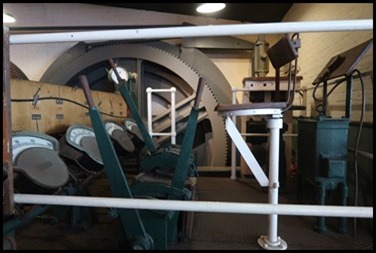 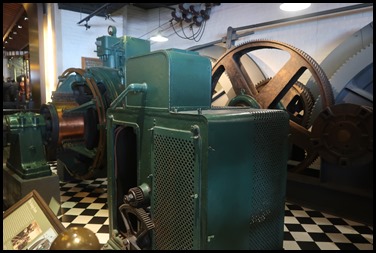 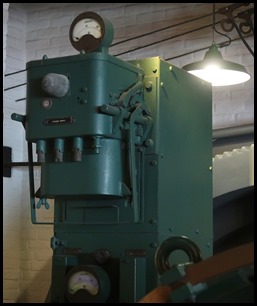 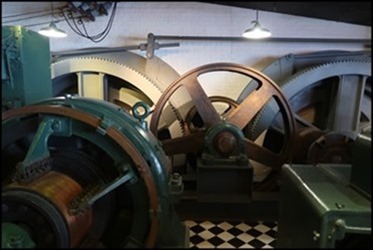 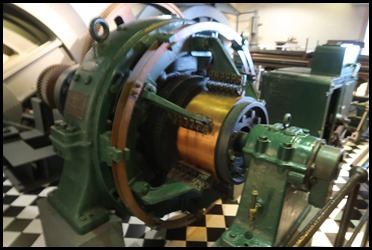 Arriving at The Peak Tram clutching
our passes we were invited to ‘jump’ the queue gathered across the road
(approximately a two hour wait), the group queue all up the hill as far as we
could see and settled in the main hall. We still had to wait just over half an
hour which gave me time to photograph the exhibits and old
engine parts.
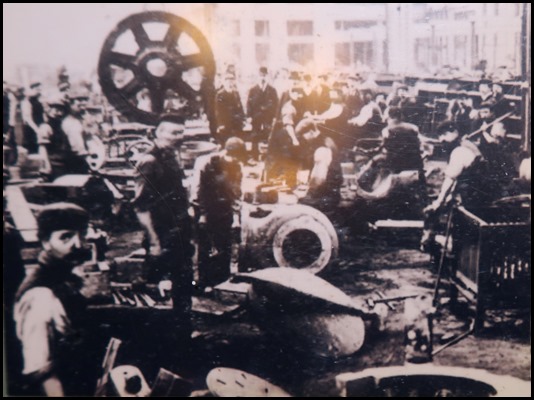 An early 20th-century view of the
Metropolitan-Vickers iron foundry located on the
Trafford Park Estate, Manchester. Given the large scale of the works, the
foundry was able to cast parts for other companies as well.
 The
workings.
 The Haulage Room circa 1930. On
the right is the 4.5-ton flywheel which took over two hours to come to a
complete stop once the power had been switched off. Throughout its history, the haulage room for The
Peak Tram has been located in the upper terminus building. From 1888 until 1926,
the system was operated by a steam-powered winding engine. Its impressive
3.5-metre drums hauled a steel rope along cable rollers installed between the
main rails just above the track bed. Although it is not known with certainty who
supplied the original engine, it is possible that it was constructed locally by
one of Hong Kong’s shipbuilding firms, with the enormous winding gears sent from
the United Kingdom.
The operation of the tramcars
relied on close communication between the brakeman riding aboard the carriage,
and a controller located in the haulage room of the Peak terminus. Through a
combination of bell signals sent from the tram, the controller adjusted the
power input which wound and unwound the 1,500 metres of steel rope. Sliding
metal arrows on an indicator board in front of him showed the exact position of
the two cars at all times. As the twin drums turned in unison, the
counterbalanced tramcars started and stopped simultaneously, crossing each other
at exactly the same location on every trip. While the system worked flawlessly,
Hong Kong’s climate added an unexpected twist that continues to affect its
operation. With changing seasonal temperatures, the steel cable expands and
contracts, varying the exact position of the carriage stop by up to a metre on
any given day.
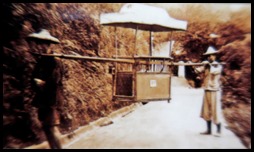 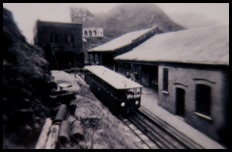 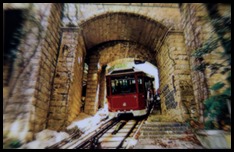 In 1873, reaching The Peak was
wholly dependent on the use of a sedan chair. With
the commencement of service on the 30th of May 1888, the
Peak Tram became the first cable funicular in Asia. Nowadays, The Peak Tram is applying microprocessor-control
technology and it carries 120 passengers per tramcar.
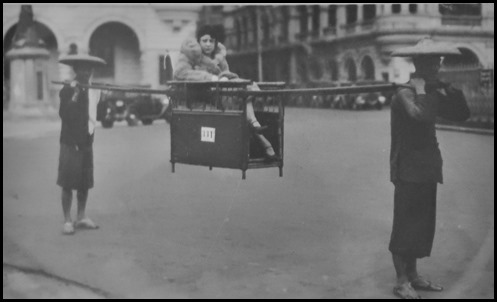 Travel by Sedan Chair: The first routes to the Peak were created by
grass-cutters making the climb on foot. While some intrepid souls occasionally
attempted to ascend on horseback, most of the paths were too steep and narrow to
warrant the risk, and Hong Kong’s climate as a whole did not really favour the
keeping of horses. This lack of easy conveyance led to a rapid growth in the use
of sedan chairs. While public chairs consisted of little more than an enclosed
seat suspended between two poles, among the gentry considerable pride was taken
in owning a more luxurious rig. The Governor’s sedan could be fully curtained
during inclement weather and was borne by eight servants sporting bright red
uniforms with tasselled hats. In the 1880s, chair fares to the hill district
cost 75 cents per hour or $4 for the day. Although perhaps less than comfortable
for those who actually used them, the sedan chair became a vivid symbol of early
life in Hong Kong. Their obvious novelty among curious viewers half a world away
provided artists and photographers with ongoing opportunities to feature them in
imaginative posters, advertising and newly stereoscopic cards.
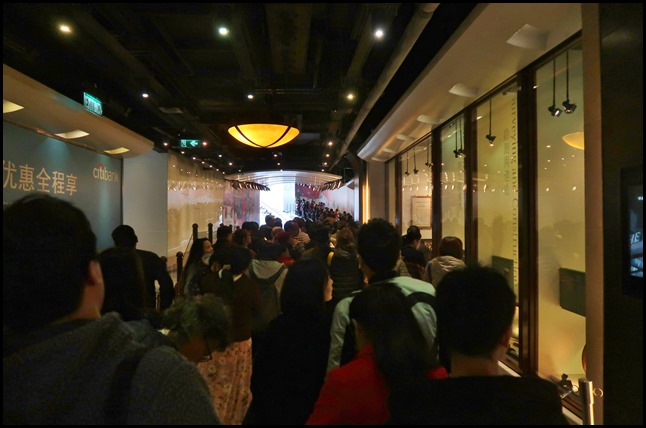 The long
queue with display cases to the right.
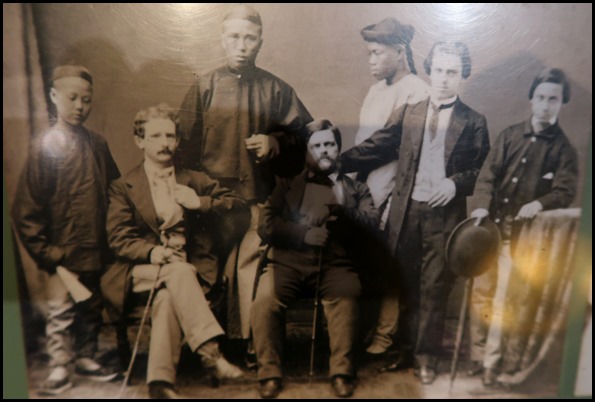 A group of
Hong Kong businessmen from Ray and Company – circa
1865.
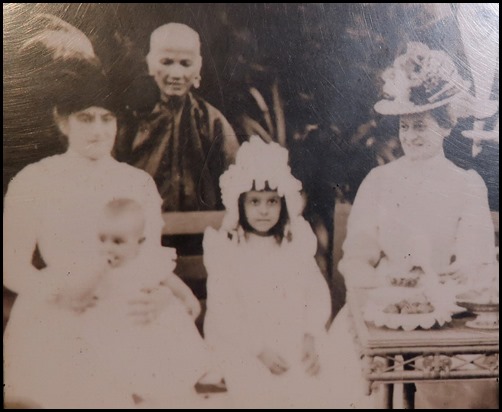 Afternoon tea at the Holyoak
residence, Hong Kong – circa 1900.
Fashions of the Day: Late
19th-century Hong Kong was no stranger to fashion. With the constant influx of
residents arriving from the continent and a capable workforce of tailors,
European clothing style remained very up to date. Hong Kong’s summers brought a
natural preference for lighter fabrics. Cotton and linen ‘tea’ dresses, or lawn
dresses were especially popular for western women who regularly met to play
cards and discuss the pleasantries of the day. For more formal visits, a
well-tailored ‘carriage dress’ with separate bodice and skirt was
required. Made of satin or silk with cut velvet trims, they were tightly fitted
at the waist and bosom but amply cut at the hem to create a full, curvaceous
silhouette.
Styles for western
men consisted of either a dark-coloured morning coat or straight ‘sack’ suit.
However, in a nod to fashions abroad, lively patterned waistcoats became
popular, offsetting this otherwise sombre attire. Often made of fine Chinese
silk, the waistcoat was an essential part of a gentleman’s wardrobe and was only
dispensed with by those doing heavy manual labour.
During the
same period, Chinese merchants and administrators generally opted for a
dark-coloured ma gua, or jacket, worn over a long, full-sleeved robe,
known as a chang shan. These were made of cotton or brocade depending
on one’s status.
Handsewn cloth shoes and a silk
cap completed the wardrobe. Men throughout China also wore a hair braid known as
a queue. Originally a symbol of subservience to China’s Manchu rulers, the fall
of the Qing dynasty in 1911 brought an end to the practise with Hong Kong men
shedding them almost overnight.
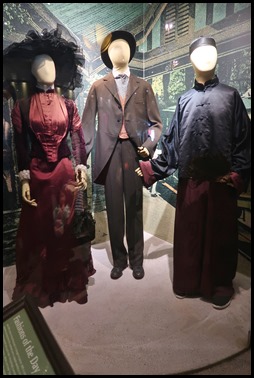  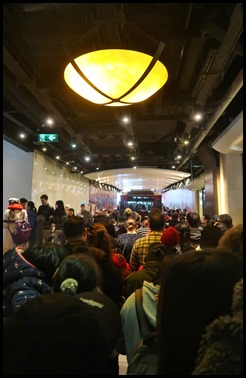 Fashion,
an advertisement of the time showing a harbour with
no tall buildings at all and a tram came in and
absorbed half the current queue, ten more minutes to wait.
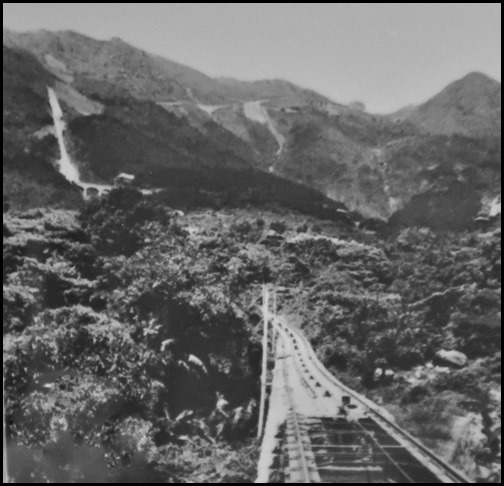 The first Peak
Tram ran on the 30th of May 1888. A view of the tram
line soon after completion taken by general contractor Mr Sun Shing.
There is a noticeable lack of neighbouring buildings or other construction in
the area.
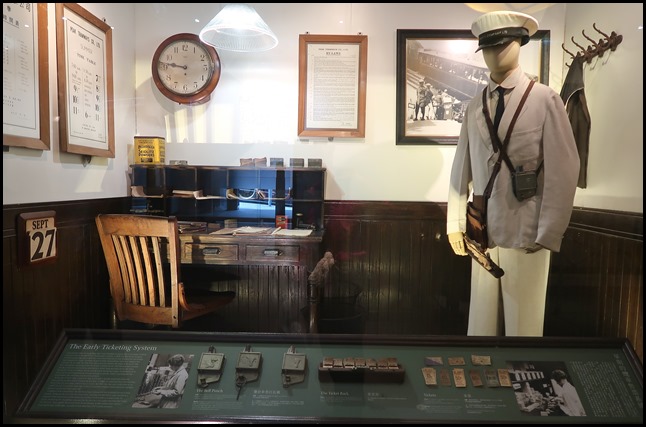 The Early Ticketing System: From an early date, the Hong Kong High
Level Tramways Company used a formalised ticketing process known as the Bell
Punch. Established in London in 1878, the Bell Punch
Company Limited acquired the patent rights to hand-held ticket
punch from America that had already been adopted by London Tramways as well as
other transportation systems in Glasgow and Liverpool. By the time The Peak Tram
introduced this method, the shape of the punch had been redesigned, becoming
known as the box or breast punch. This idea was well received among conductors
as it could be attached to a leather strap and worn across the chest, leaving
the conductor’s hands free for issuing tickets and giving change. Fundamental to
its name and its enduring popularity among passengers was the cheerful sounding
bell that chimed when the ticket was inserted and validated.
At the start of
each shift, a conductor was issued with a wooden ticket rack filled with stacks
of pre-counted tickets arranged by fare type. In 1888, an uphill journey in the
first class section cost 30 cents while the downhill was 15 cents. By 1945, this
had risen to 60 cents for an uphill ride and 10 cents for every dog. Soldiers
and workers enjoyed discounted fares but were seated in second and third class
rows.
In addition to
its convenience, the Bell Punch was
tamperproof and simplified the accounting process. At the end of each shift, the
ticket rack, cash bag and Bell Punch were handed to a supervisor who would
balance the remaining number of tickets with the counter inside the punch.
Accessing the counter was only possible by piercing a thin paper seal mounted
inside the machine. Once closed, the punch could not be opened, or the counter
reset, without breaking the seal. In this way, accurate records were kept and
honesty prevailed.
 Ticket
sorting.
Life at the Peak: By 1888, Hong
Kong’s population had reached 173,475 with some 30-40 families calling The Peak
their home. The Peak Hotel had opened in 1873 and was attracting a clientele
eager to escape the oppressive heat below. In preparation for the opening of the
tram on the 30th of May, free rides were offered the day before. This unexpected
opportunity attracted a sizeable crowd and stirred enough interest that, when
the tram opened for regular service the following day, more than 600 passengers
gathered to wait their turn to the top.
The tram’s novelty was part of a
wider 19th-century fascination with all things mechanised, exotic and new. As
individual travel became more widespread, trains and trams, were immortalised in
the music and advertising of the period. Salons were hosted that offered that
offered opportunities to hear personal accounts of adventurous exploits, often
accompanied by magic lantern slides.
Within the first year of
operation, the tram had carried as many as 150,000 passengers. Hong Kong’s
residents were quick to use this new amenity, spurring a building boom and
ushering in a new pastime of leisurely picnics at the Peak.
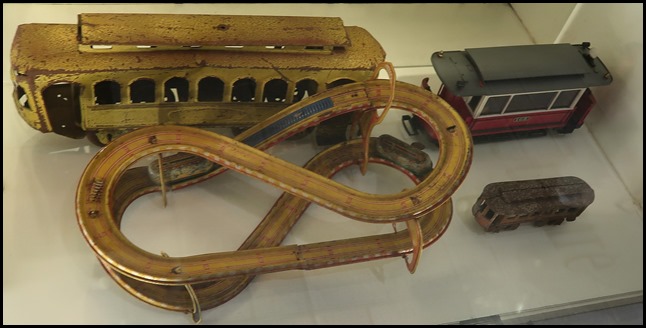 A Playful Passion: Perhaps no
other types of toys have matched the widespread popularity of trams, trains and
trolleys. For most cultures they represent the first forms of motorised
transportation. Since their appearance in the early 19th century, such toys have
captured the hearts of generations of children and adults alike. While many
models have been reproduced commercially in materials ranging from cast iron,
pressed tinplate and printed paper on wood, individual craftsmen have also
enjoyed the challenge of building their own special versions. Gathered here are
examples of commercially manufactured trolleys and trams, as well as many made
by hand. Whether cut from scrap metal in a rural Mexican village, or glued
together from cardboard during America’s depression years, interest in rail
vehicles has never waned. Over the years, Hong Kong’s Peak and Peak Tram have
been reproduced in a great variety of entertaining forms. From jigsaw puzzles,
books and board games, to Viewmaster disks and even playing cards, this ongoing
presence of the tram in popular culture has helped remind us of its role in the
city’s history and is a fitting tribute to Asia’s oldest funicular tramway.
Indeed, at the top we saw many exquisite models (big price tag) down to tiny
plastic keyrings.
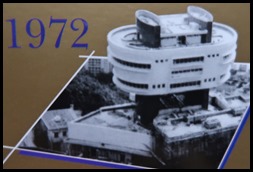 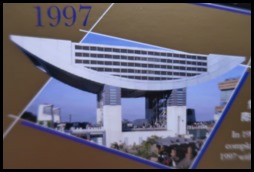 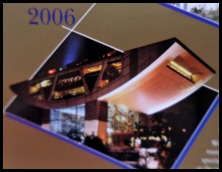 The construction of the original
Peak Tower began in 1971 and it has since gone
through a number of reincarnations. Housing the upper terminus of the Peak Tram,
The Peak Tower is situated in Victoria Gap, a dip along the line of the hills at
an elevation of 396 metres. It was first unveiled to the public on the 29th of
August 1972.
In 1993, The Peak Tower underwent
a HK$500-million redevelopment into a new retail and entertainment complex,
designed by renowned British architect Terry Farrell. It was officially opened
to the public in May 1997 with a number of top attractions, including Ripley’s
Odditorium and Mini Motion Theatre.
Work on the revitalisation of The
Peak Tower began in March 2005. This extensive program has transformed The Peak
Tower as an essential leisure destination offering great variety of dining,
specialty shopping and interactive entertainment for Hong Kong residents and
tourists alike. Located on the roof of The Peak Tower, the Sky Terrace 428
standing at 428 metres above sea level is the highest viewing terrace in Hong
Kong offering a stunning 360-degree panoramic views.
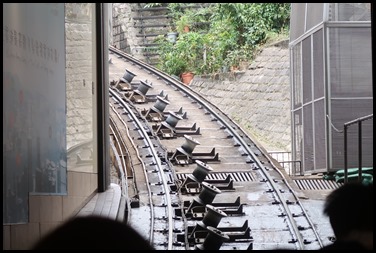 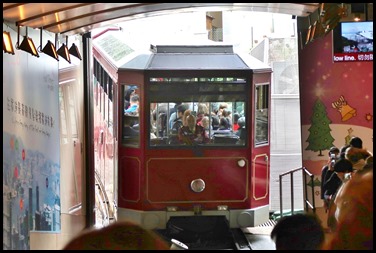 We finally got to stand near the track and then our tram arrived.
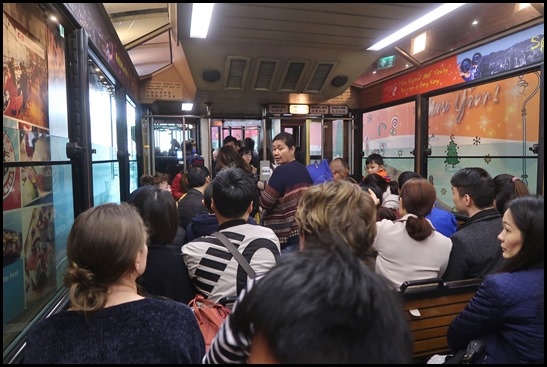 Both the cars were full in a couple of minutes. Each tramcar can hold 95
seated and 25 standing passengers.
 Building
site to our left.
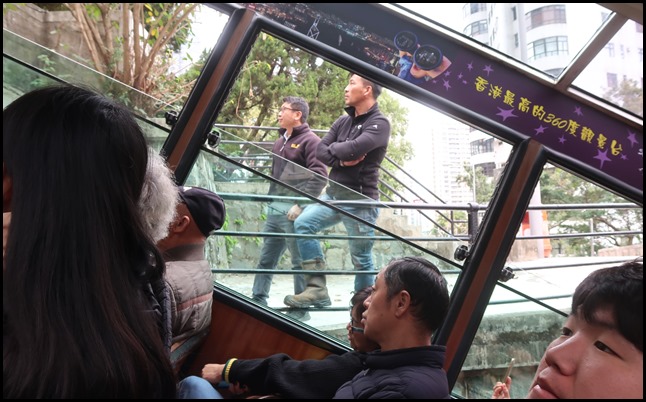 The steepest part
of our five minute journey felt like the climb on a rollercoaster. The
maximum steepness is 48% with track
gradient between four and twenty seven degrees.
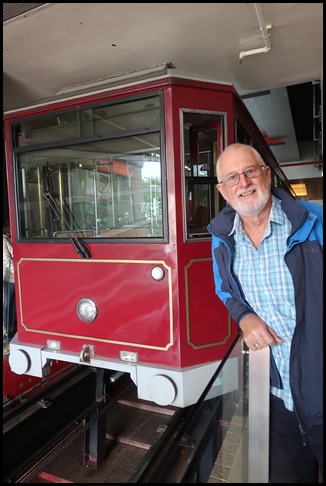 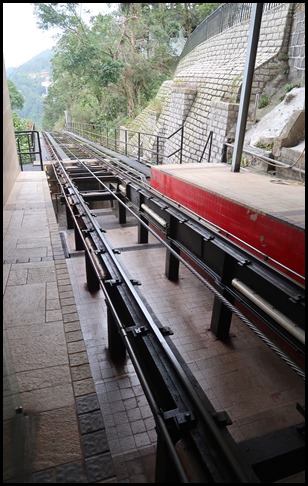 At the top Bear posed with our chariot and we looked down the
track.
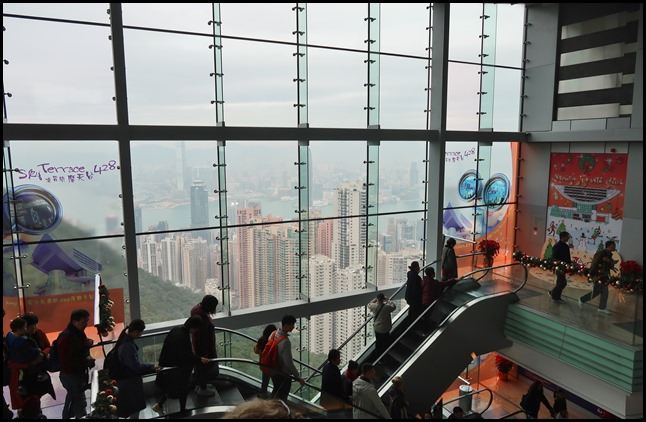 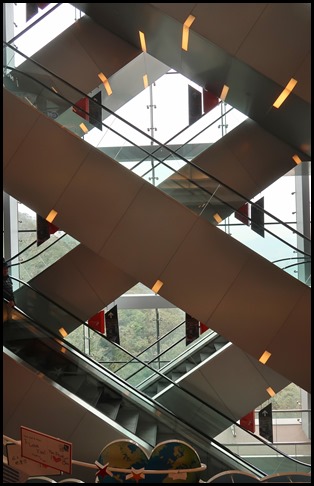 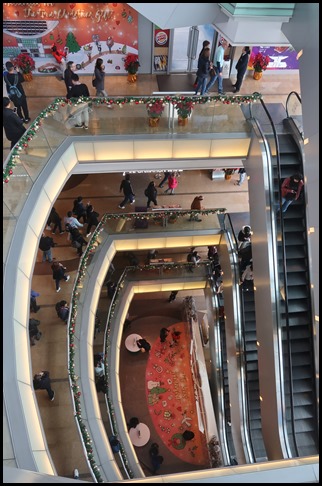 The escalators
inside.
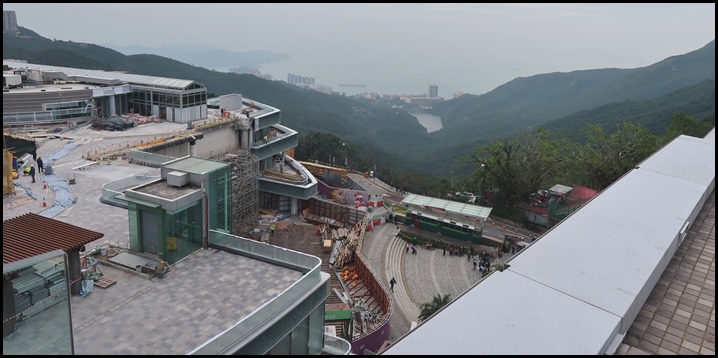 Loads of work
ongoing outside. The Pok Fu Lam Reservoir in the
background. Lamma Island far left in the mist. Hiking trails to the
right.
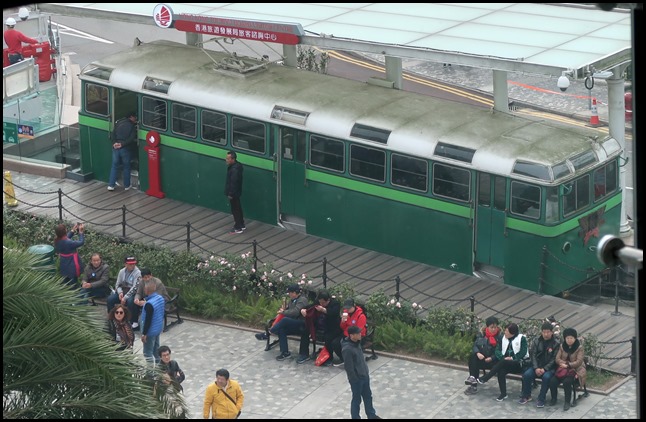 Below, we could
see a 1956 tramcar, now a visitor attraction. We
headed for the roof view.
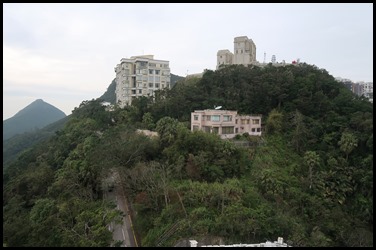 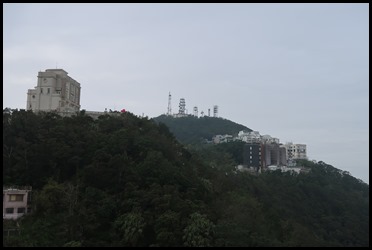  Some of The Peak properties we could see from the
rooftop.
A quote from South China Morning Post dated August 2014: Ignoring the Hong Kong government’s attempt to rein in home prices, Sun Hung Kai Properties (SHKP) is offering a super-deluxe house on The Peak for HK$175,735 per square foot. If it fetches that amount, it will be the world’s most expensive home in terms of price per square foot. SHKP released the price of the 12 houses at Twelve Peaks in 12 Mount Kellett Road on Wednesday night, with the priciest, No 1, going for HK$819.1 million. If people completed in one hundred and fifty days they received a three per cent discount................. 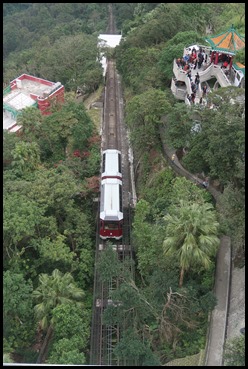 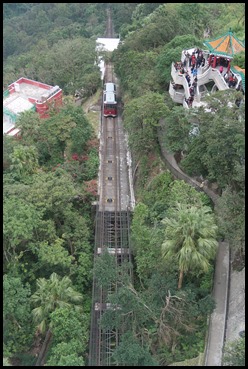  We bimbled around
on the roof observation level and at the far side looked down as a tram headed down the hill and disappeared around the bend. About
seventeen thousand people use the service every day. We enjoyed a picnic, took
in the views, then took the escalator to each floor to look in many of the
shops. A candy bar (doing a thriving business) sold flying saucers. I hadn’t
eaten this sherbet treat in years and Bear picked a bag up. Just a few ounces at
seven pounds I asked that they be returned from whence they
came.......
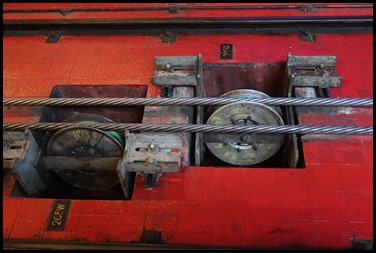 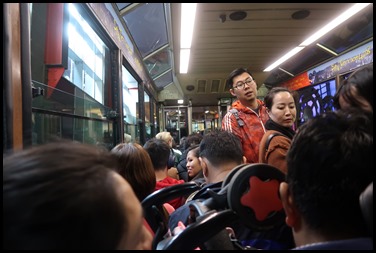 When it was time
to go we joined the very long queue, at one point we thought about walking down
but waited it out and after forty-five minutes we were ushered in to the
platform area, here we watched the steel rope moving
up and down on rollers. The tram arrived and we settled in the back row of an
equally crowded tramcar as the one on the uphill
journey.
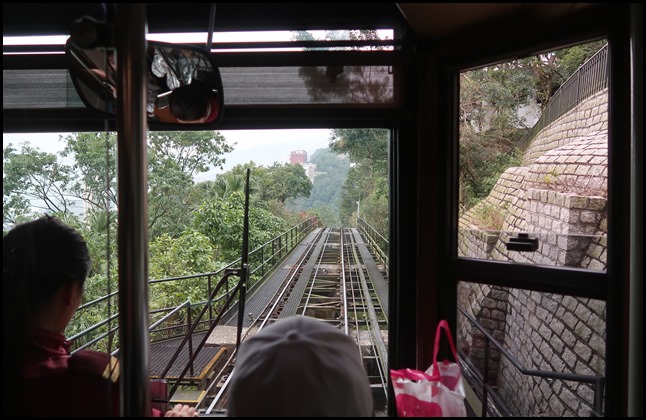 Going backwards
meant we were actually at the front but facing the wrong way. I stood and
swiveled on the spot and save for one person standing in the way had a good
view of the track and managed to take a video as we
passed the uphill tramcar at The Passing Loop.
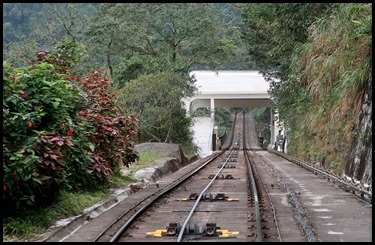 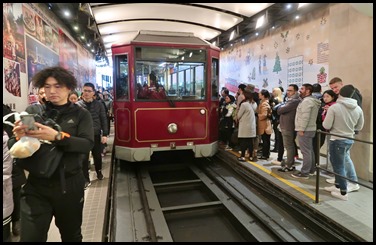 A steeper bit. Once at the bottom another measured dose were ready to board. And
finally......
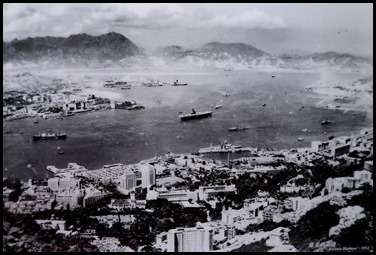 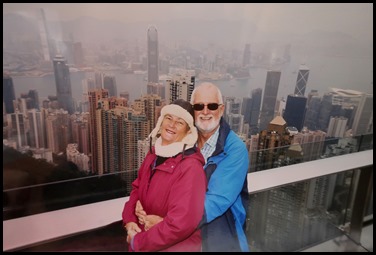 ..........Victoria
Harbour 1952, us and the harbour view today.
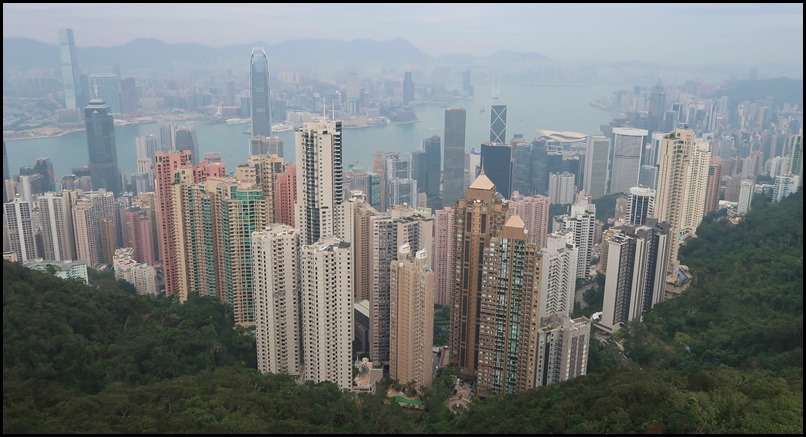 ALL IN ALL SUCH A GOOD
EXPERIENCE
CROWDED BUT SO MUCH
FUN |